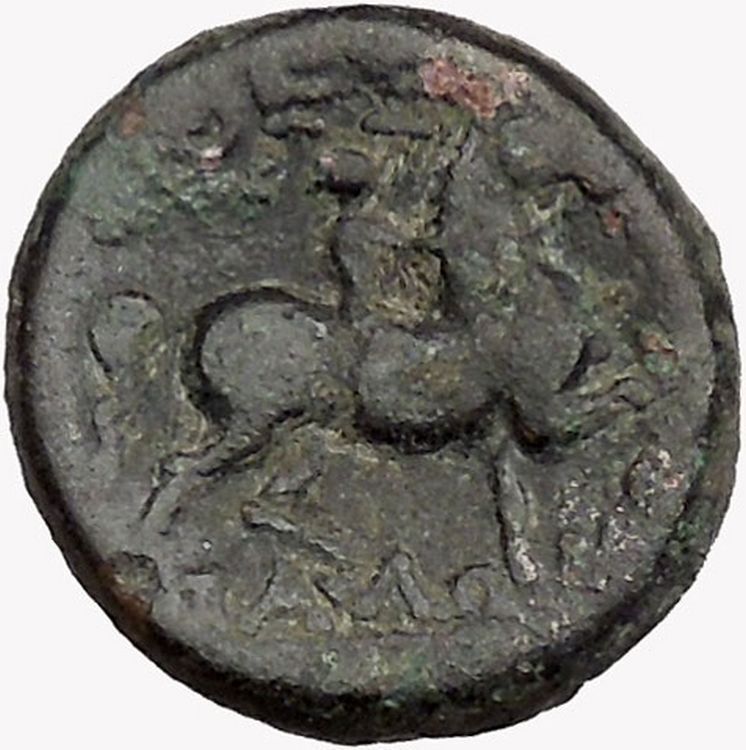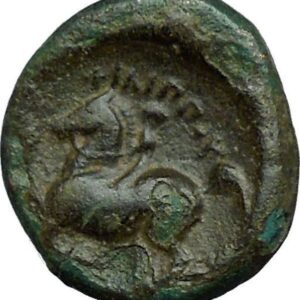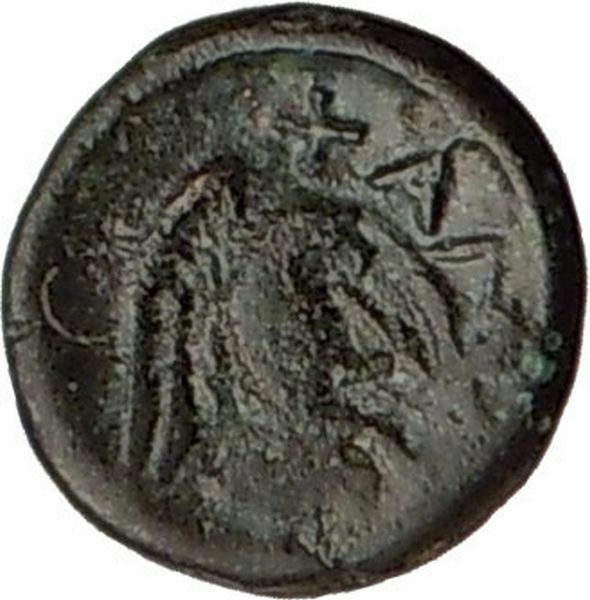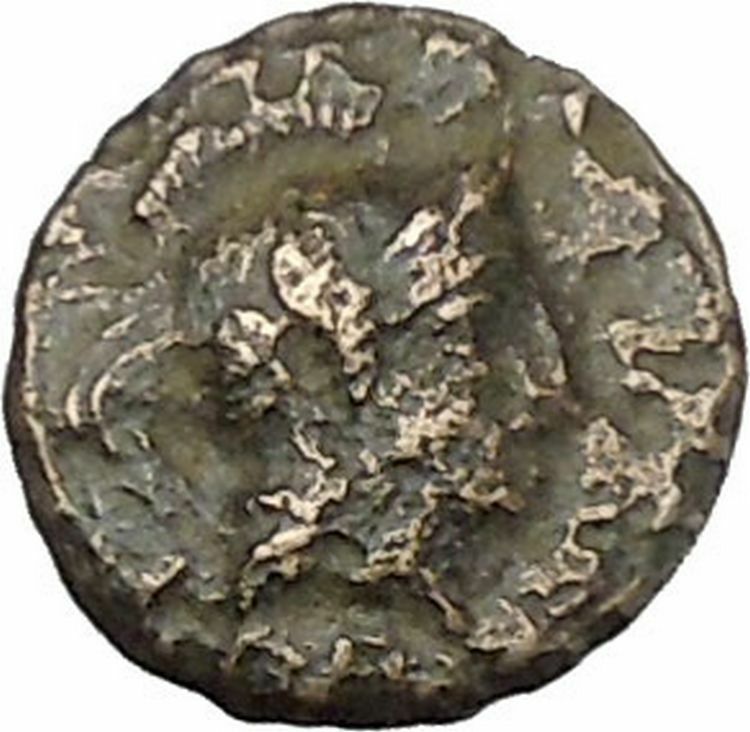|
Greek city of
Tarsos
in
Cilicia
Bronze 19mm (7.11 grams) Struck 2nd-1st Century B.C.
Reference: Sear 5672 var.
Veiled and turreted head of Tyche right, dotted border.
Pyre of Sandan, in the form of pyramidal structure, containing figure of Sandan
on lion, surmounting square basis; eagle perched on apex; TAPΣΕΩΝ
in field to right, monogram in field to left.
Hittite/Babylonian sun, storm,
or warrior god, also perhaps associated with agriculture, who the Greeks equated
with Herakles (Hercules) and who the Lydians believed their royal house
descended from. Sardis (Sardes, Sardeis), the capital of Lydia, may have been
named after Sandon. “In honour of Sandan-Heracles there was celebrated every
year in Tarsus a funeral pyre festival, at the climax of which the image of the
god was burned. The dying of nature under the withering heat of the summer sun
and its resurrection to new life was the content of this mystery, which at once
suggests its kinship with the cults of the Syrian Adonis, the Phrygian Attis,
the Egyptian Osiris, and the Babylonian Tammuz.” The pyre of Sandan is featured
on coins of Tarsus. Sandan is also associated on coinage with a lion.
The first city of Cilicia and
capital of the native rulers down to circa 400 B.C., Tarsus was situated in the
fertile eastern plain on the river Kydnos, about 12 miles from the sea. In the
4th century, until the arrival of Alexander in 333 B.C., Tarsus was the chief
mint of the Persian satraps. Eventually, in the 1st century B.C., it became the
capital of the Roman province of Cilicia.
You are bidding on the exact
item pictured, provided with a Certificate of Authenticity and Lifetime
Guarantee of Authenticity.
Tyche (Greek for luck; the Roman equivalent
was Fortuna
) was the presiding
tutelary deity
that governed the fortune and
prosperity of a city, its destiny. Increasingly during the Hellenistic period,
cities had their own specific iconic version of Tyche, wearing a
mural crown
(a crown like the walls of the
city).

The
Greek historian Polybius
believed that when no cause can be
discovered to events such as floods, droughts, frosts or even in politics, then
the cause of these events may be fairly attributed to Tyche.
Stylianos Spyridakis concisely expressed Tyche’s appeal in a Hellenistic
world of arbitrary violence and unmeaning reverses: “In the turbulent years of
the Epigoni of Alexander
, an awareness of the
instability of human affairs led people to believe that Tyche, the blind
mistress of Fortune, governed mankind with an inconstancy which explained the
vicissitudes of the time.”
In literature, she might be given various genealogies, as a daughter of
Hermes
and
Aphrodite
, or considered as one of the
Oceanids
, daughters of
Oceanus
and
Tethys
, or of
Zeus. She was connected with
Nemesis
and
Agathos Daimon
(“good spirit”).
She was uniquely venerated at
Itanos
in Crete, as Tyche Protogeneia,
linked with the Athenian
Protogeneia
(“firstborn”), daughter of
Erechtheus
, whose self-sacrifice saved the
city.
She had temples at
Caesarea Maritima
,
Antioch
,
Alexandria
and
Constantinople
. In
Alexandria
the Tychaeon, the temple of
Tyche, was described by
Libanius
as one of the most magnificent of the
entire Hellenistic world.
Tyche appears on many
coins
of the Hellenistic period in the three
centuries before the Christian era, especially from cities in the Aegean.
Unpredictable turns of fortune drive the complicated plotlines of
Hellenistic romances
, such as
Leucippe and Clitophon
or
Daphnis and Chloe
. She experienced a
resurgence in another era of uneasy change, the final days of publicly
sanctioned
Paganism
, between the late-fourth-century
emperors
Julian
and
Theodosius I
who definitively closed the
temples. The effectiveness of her capricious power even achieved respectability
in philosophical circles during that generation, though among poets it was a
commonplace to revile her for a fickle harlot.
In medieval art
, she was depicted as carrying a
cornucopia
, an
emblematic
ship’s rudder, and the
wheel of fortune
, or she may stand on the
wheel, presiding over the entire circle of fate.
The constellation of
Virgo
is sometimes identified as the heavenly
figure of Tyche, as well as other goddesses such as
Demeter
and
Astraea
.
Sandan was the
Anatolian
(Hittite)
lion god during the Classical period. He used to be represented in association
with a horned lion, and often resided inside a pyre surmounted by an eagle.
Sandan was often associated to the Greek god
Herakles
. In ceremonies, an image of the god
was placed inside a pyre and was set on fire.
Sandan appears in the coins of the
Seleucids
, as well as on other coins of
Tarsus
(Cilicia)
during the time of the Roman emperors.
A pyre (Greek:
πυρά, pyrá, from πυρ, pýr, fire), also known as a funeral pyre,
is a structure, usually made of
wood, for burning a body as part of a
funeral
rite. As a form of
cremation
, a body is placed upon the pyre,
which is then set on fire
.
Uses
Religious
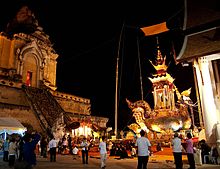
The funeral pyre of Chan Kusalo (the Buddhist high monk of Northern
Thailand) at
Wat Chedi Luang
, Chiang Mai,
Thailand
Traditionally, pyres are used for the cremation of the deceased in the
Hindu
and
Sikh
religions, a practice which dates back
several thousands of years.
Funeral pyres were also used in
Viking
culture, typically on floating boats, as
well as by the
Romans
.
Tarsus (Greek:
Ταρσός,
Armenian
: Տարսոն, Darson) is a
historical city
in
south-central Turkey
, 20 km inland from
Mediterranean Sea
. It is part of
Adana-Mersin Metropolitan Area
, fourth largest
metropolitan area
in
Turkey
with a
population of 2.75 million. Tarsus is an administrative district in
Mersin Province
and lies in the core of
Çukurova
, a
geographical, economical and cultural region.
With a history going back over 9,000 years Tarsus has long been an important
stop for traders, a focal point of many civilisations including the
Ancient Romans
when Tarsus was capital of the province of
Cilicia
,
scene of the first meeting between
Mark
Antony
and
Cleopatra
and birthplace of
Saint Paul
.
//
Geography
Located on the mouth of the Tarsus Çay (Cydnus),
which empties into the
Mediterranean Sea
, Tarsus is a junction point of land and sea routes
connecting the Cilician
plain (today called
Çukurova
),
central Anatolia
and the Mediterranean sea. The climate is typical of the
Mediterranean
region, summers very very hot, winters chilly and damp.
Tarsus has a long history of commerce and is still a commercial centre today,
trading in the produce of the fertile Çukurova plain; also Tarsus is a thriving
industrial centre refining and processing that produce same for export.
Industries include agricultural machinery, spare parts, textiles,
fruit-processing, brick building and ceramics.
Agriculture is an important source of income, half of the land area in the
district is farmland (1,050 km²) and most of the remainder is forest and
orchard. The farmland is mostly well-irrigated, fertilised and managed with the
latest equipment.
Etymology
The ancient name is Tarsos, (Greek:
Ταρσός) possibly derived from a
pagan god, Tarku; at other times the city was named Tarsisi;
Antiochia on the Cydnus (Greek:
Αντιόχεια του Κύδνου,
Latin
:
Antiochia ad Cydnum); and Juliopolis. [Տարսոն, Darson in
Western Armenian
and Tarson in
Eastern Armenian
] . The
Hittites
referred to Tarsus as Tarsa.[1]
Pegasus
the winged horse was a mortal. Because of his faithful service to Zeus the Greek
god, he was honored with a constellation.[5] On the last day of pegasuses life,
Zeus transformed him into a constellation, then a single feather fell to the
earth near the city of Tarsus {Ταρσός} in Greek.
History
Antiquity
Foundation
and prehistory
Excavation of the mound of Gözlükule reveals that the prehistorical
development of Tarsus reaches back to the
Neolithic Period
and continues unbroken through
Chalcolithic
and
Early Bronze Ages
.
The settlement was located at the crossing of several important trade routes,
linking Anatolia
to Syria
and beyond. Because the ruins are covered by the modern city, archaeology has
barely touched the ancient city. The city may have been of
Semitic
origin; it is mentioned as Tarsisi in the campaigns of
Esarhaddon
,
as well as several times in the records of
Shalmaneser I
and
Sennacherib
. A Greek legend connects it with the memory of
Sardanapalus
(Ashurbanipal), still preserved in the Dunuk-Tach, called ‘tomb
of Sardanapalus’, a monument of unknown origin.
Stephanus of Byzantium
quotes
Athenodorus of Tarsus
as relating another legend:
|
“
|
Anchiale, daughter of
Iapetus
, founded Anchiale (a city near Tarsus): her son was
Cydnus
, who gave his name to the river at Tarsus: the son of Cydnus
was Parthenius, from whom the city was called Parthenia: afterwards the
name was changed to Tarsus.
|
”
|
Much of this legend of the foundation of Tarsus, however, appeared in the
Roman era, and none of it is reliable. The geographer
Strabo
states
that Tarsus was founded by people from
Argos
who were
exploring this coast. Another legend states that the winged horse
Pegasus
was
lost and landed here, hurting his foot, and thus the city was named tar-sos
(the sole of the foot). Other candidates for legendary founder of the
city include the hero
Perseus
and
Triptolemus
son of the earth-goddess
Demeter
,
doubtless because the countryside around Tarsus is excellent farmland. Later the
coinage of Tarsus bore the image of
Hercules
,
due to yet another tale in which the hero was held prisoner here by the local
god Sandon
.
Tarsus has been suggested as a possible identification of the biblical
Tarshish
,
where the prophet Jonah
wanted to flee, but
Tartessos
in Spain is a more likely identification for this. (See further[2])
Early
antiquity, Greece and Persia
In historical times, the city was first ruled by the
Hittites
,
followed by Assyria
, and then the
Persian Empire
. Tarsus was the seat of a Persian
satrapy
from
400 BC onward. Indeed,
Xenophon
records that in 401 BC, when
Cyrus the Younger
marched against
Babylon
, the
city was governed by King
Syennesis
in the name of the Persian monarch.
Alexander the Great
passed through with his armies in 333 BC and nearly met
his death here after a bath in the Cydnus. By this time Tarsus was already
largely influenced by
Greek language and culture
, and as part of the
Seleucid Empire
it became more and more
hellenized
. Strabo praises the cultural level of Tarsus in this period with
its philosophers, poets and linguists. The schools of Tarsus rivaled
Athens
and
Alexandria
.
2
Maccabees
(4:30) records its revolt in about 171 BC against
Antiochus IV Epiphanes
, who had renamed the town Antiochia on the Cydnus.
In his time the library of Tarsus held 200,000 books, including a huge
collection of scientific works. The name didn’t last, however, due to the
confusion of so many cities named Antioch.
Rome

Oscillum depicting a couple kissing.
Terracotta
figurine made in Tarsus,
Roman Era
Pompey
subjected Tarsus to Rome, and it became capital of the Roman province of
Cilicia
, the
metropolis where the governor resided. In 66 BC, the inhabitants received Roman
citizenship. To flatter
Julius Caesar
, for a time it took the name Juliopolis. It was also
here that
Cleopatra
and
Mark
Antony
met and was the scene of the celebrated feasts they gave during the
construction of their fleet (41 BC).
When the province of Cilicia was divided, Tarsus remained the civil and
religious metropolis of Cilicia Prima, and was a grand city with palaces,
marketplaces, roads and bridges, baths, fountains and waterworks, a gymnasium on
the banks of the
Cydnus
, and a stadium. Tarsus was later eclipsed by nearby
Adana
, but
remained important as a port and shipyard. Several Roman emperors were interred
here:
Marcus Claudius Tacitus
,
Maximinus
, and
Julian the Apostate
, who planned to move his capital here from Antioch if he
returned from his Persian expedition.[3]
Christianity
Tarsus was the birthplace of
Saint Paul
(Acts
9:11; 21:39; 22:3), who returned here after his conversion (Acts 9:30). From
here Barnabas
retrieved him to help with the work in Syrian Antioch (Acts 11:25). Already by
this time a Christian
community probably existed, although the first recorded bishop,
Helenus
, dates only from the third century; Helenus visited
Antioch
several times in connection with the dispute concerning
Paul of Samosata
. Later
bishops of Tarsus
included
Lupus
, present at the
Council of Ancyra
in 314; Theodorus, at the
Council of Nicaea
in 325; Helladius, who was condemned at the
Council of Ephesus
and who appealed to the bishop of Rome in 433; above all
the celebrated exegete Diodorus, teacher of
Theodore of Mopsuestia
and consequently one of the fathers of
Nestorianism
.[4]
From the sixth century the metropolitan see of Tarsus had seven suffragan
bishoprics;[5]
the
Ecumenical Patriarchate of Constantinople
archdiocese is again mentioned in
the tenth century ([6]),
and has existed down to the present day, part of the
Patriarchate of Antioch
.
Owing to the importance of Tarsus, many martyrs were put to death here, among
them being
Saint Pelagia
,
Saint Boniface
,
Saint Marinus
,
Saint Diomedes
,
Saint Quiricus and Saint Julitta
.
At about the end of the tenth century, the Armenians established a diocese of
their rite, which still exists;
Saint Nerses of Lambroun
was its most distinguished representative in the
twelfth century.
A cave in Tarsus is one of a number of places claiming to be the location of
the legend of the
Seven Sleepers
, common to Christianity and Islam.
Islam
and beyond
The Tarsus region was annexed by the Forces of
Rashidun Caliphate
under the command of
Khalid ibn Walid
in 637. Tarsus was on the edge of the de facto border with
the Byzantine empire in this period of the
Taurus Mountains
range separating the
Armeniac
and
Anatolic
themes
from Cilicia, Syria and northern Iraq. Tarsus was near the
strategically important
Cilician Gates
which passed through the Taurus Mountains as well as access
to the Mediterranean Sea which was used for both land and naval operations
further in the Byzantine territory. While the region was lost by the Byzantine
Emperor Heraclius
in 637, it is unclear when the city was permanently
occupied by the Arabs as sources indicate the city was garrisoned and retaken
multiple times until the 9th century.[7]
According to the Arabic geographer
Ibn Hawqal
and the accounts of Arab historian Abu Amr Al-Tarsusi, Tarsus was a stronghold
of Muslim forces with thousands of volunteers from across the Islamic world
coming to fight in jihad against the Byzantine Empire. The city was a base of
operations for the regular summer raids (ṣawāʿif) into Byzantine lands
through the Cilician Gates when the mountain snows had melted and passage was
possible. Later the city was used in defense of the frontier in response to a
resurgent Byzantine empire in the mid-10th century.[8]
The city was lost in 965, when
Nicephorus Phocas
returned it to the
Byzantine Empire
for nearly a century. The area was retaken by the
Seljuk Turks
, recaptured in 1097 during the
Crusades
and then disputed between Latins, Greeks, and Armenians of the
Armenian Kingdom of Cilicia
(Kingdom of Lesser Armenia); these last became
definitively masters until about 1360, when it was captured by the
Ramazanoğlu
Turks. Finally, the area was brought under the control of the
Ottomans
by Selim I
in 1517.
In the Middle Ages Tarsus was renowned throughout the Middle East; a number
of Arab writers praised it as a beautiful and well-defended city, its walls
being in two layers with five gates and earthworks outside, surrounded by rich
farmland, watered by the river and the lake. By 1671 the traveller
Evliya Çelebi
records “a city on the plain, an hour from the sea,
surrounded by strong walls two-storeys high, moated on all sides, with three
distinct neighbourhoods inside the walls”.
Despite its excellent defences, Tarsus was captured from the Ottomans in 1832
by the
Mamluks
of
Ibrahim Pasha of Egypt
, son of
Muhammad Ali
, and for 8 years remained in the hands of the Egyptians, who
began growing cotton on the surrounding plain. Upon the return of the Ottomans
this cotton drove a substantial growth in the economy of the area, due to
increased world demand for the crop during shortages caused by the
U.S. Civil War
. A new road was built to the port in
Mersin
and the
city of Tarsus grew and thrived. Still today many large houses in the city stand
as reminders of the wealth generated during this period. However after being a
port for 3,000 years, by the end of the 19th century neglect resulted in Tarsus
no longer having access to the sea, and the delta became a swamp. At this point
Tarsus was a typical Ottoman city with communities of Muslim Turks, Christian
Greeks and Armenians
. At the founding of the
Turkish Republic
in the 1920s the swamp was drained and the River Berdan was
dammed to build Turkey’s first hydro-electric power station. Irrigation,
roadworks and a railway brought the economy of Tarsus back to life, with new
factories, particularly producing textiles.
Life
in Tarsus today
Tarsus has slightly more in the way of culture (cinema, theatre, museums)
than most Turkish country towns, but in many ways still has a small town feel;
people walk in the road rather than on the pavements. Predictably, the people of
the mountain forests in the hinterland have an even quieter rural existence.
The local cuisine includes:
hummus
;
şalgam
(pickled turnips);
tantuni
(a sandwich of grilled meats; the tiny pizzas called “fındık
lahmacun”; and
cezerye
(a
confection made out of carrots).
Places
of interest
Tarsus has a great many ancient sites of interest, with many in need of
restoration and research. The best known include:

Church of
St. Paul
in Tarsus, (the church and the surroundings are on the
UN World Heritage
tentative list
-
Cleopatra Gate – to the west of the city, the only ancient city gate
still standing, where Anthony and Cleopatra entered the city in 41 BC,
though the “restoration” of this structure has involved covering much of it
over with shiny new stone (see
[2]
for a picture of the gate before the work was done).
-
The Roman bridge of Justinian over the Berdan River. Still in good
condition.
-
Tarsus Museum – contains lots of ancient coins and a severed mummified
arm.
Sites of religious interest and pilgrimage:
-
The church and well of St Paul.
-
The tomb of the
Seven Sleepers
, busy place of pilgrimage for Muslims today.
-
The mosque said to be the burial place of the
Prophet Daniel
.
From the Turkish era:
-
The old baths; the dark brown spots on the white marble walls are said
to be the bloodstains of
Shah Meran
, the legendary Snake King who was killed in an ambush in the
baths.
-
Tarsus American College
; founded in the Ottoman period, still active
today.
-
“Nusret
(Nusrat)” the
minelayer
used to defend the straits before the
Battle of Gallipoli
is being restored in Tarsus; it is to be part of a
memorial park to those lost in the fighting.
Places of natural beauty include:
-
Tarsus Waterfall; since the construction of the Berdan dam the water of
the Tarsus river has been distributed in canals for irrigation, with the
result that the waterfall can now be seen only in seasons of very heavy
rainfall.
Notable
residentss
-
Antipater
,
Stoic
philosopher
-
Caliph
Al-Ma’mun
died near Tarsus
-
Journalist
Oral Çalışlar
was born in Tarsus.
-
Chrysippus
, Stoic philosopher
-
Cleopatra
-
Lokman
the Physician
-
Mark Antony
-
Saint
Nerses of Lambron
, Archbishop of Tarsus in the
Armenian Kingdom of Cilicia
-
Paul the Apostle
(Saul
of Tarsus), Christian apostle, missionary, martyr, and saint, was born
here and returned for a brief period later in life.
-
Saint
Theodore of Tarsus
,
Archbishop of Canterbury
.
-
Tarsus is one of a number of cities that claims to be the burial place
of
Bilal ibn Rabah
, first
muezzin
,
or caller to prayer, in Islam.
-
Tarsus Idman Yurdu
is the local football team.
|








